
Global meat production in 2024 is projected to expand marginally to 371 million tonnes (carcass weight equivalent), according to the latest FAO report.
Increases in production are anticipated in all regions except Asia, particularly due to a decline in pork production in China.
In 2024, the projected expansion of global meat production is likely to be driven by poultry meat, which is estimated to grow by 1.1 million tonnes, or 0.8 percent annually, to 146 million tonnes. This expansion will be primarily driven by strong consumer demand for poultry meat due to its relative affordability and the impact of relatively low feed costs on prices, despite the risks arising from highly pathogenic avian influenza (HPAI) outbreaks and high operational costs in top producing countries.
Global production of beef and sheep meat is also estimated to further expand in 2024, supported by ample supplies of cattle ready for slaughter. However, limited consumer purchasing power due to slow economic growth and relatively high beef prices will likely constrain demand and affect production growth prospects.
In contrast, global pork production is forecasted to decline by about 1.2 million tonnes or 0.9% compared to 2023. This reduction will be mainly due to an anticipated decrease in China, resulting from government efforts to curb oversupply and maintain domestic price stability by reducing the breeding sow herd and adjusting the national pig inventory target.
Global trade in meat and meat products is expected to rebound after two consecutive years of contraction. The recovery will be mainly driven by solid import demand expected across all regions, particularly in North America. However, this positive outlook could be impacted by trade restrictions arising from the spread of animal diseases, geopolitical factors, and reduced consumer purchasing power.
According to the FAO Meat Price Index, international meat prices have risen moderately from January to May this year, despite a slowing pace of price increases in recent months. Price increases were recorded for beef, poultry, and pork, primarily supported by strong demand from major importing countries, despite increased supplies from major meat exporters.
In contrast, international prices for sheep meat have declined, mainly due to ample exportable supplies from Oceania, the world's largest supplier. (Photo: Dreamstime)




